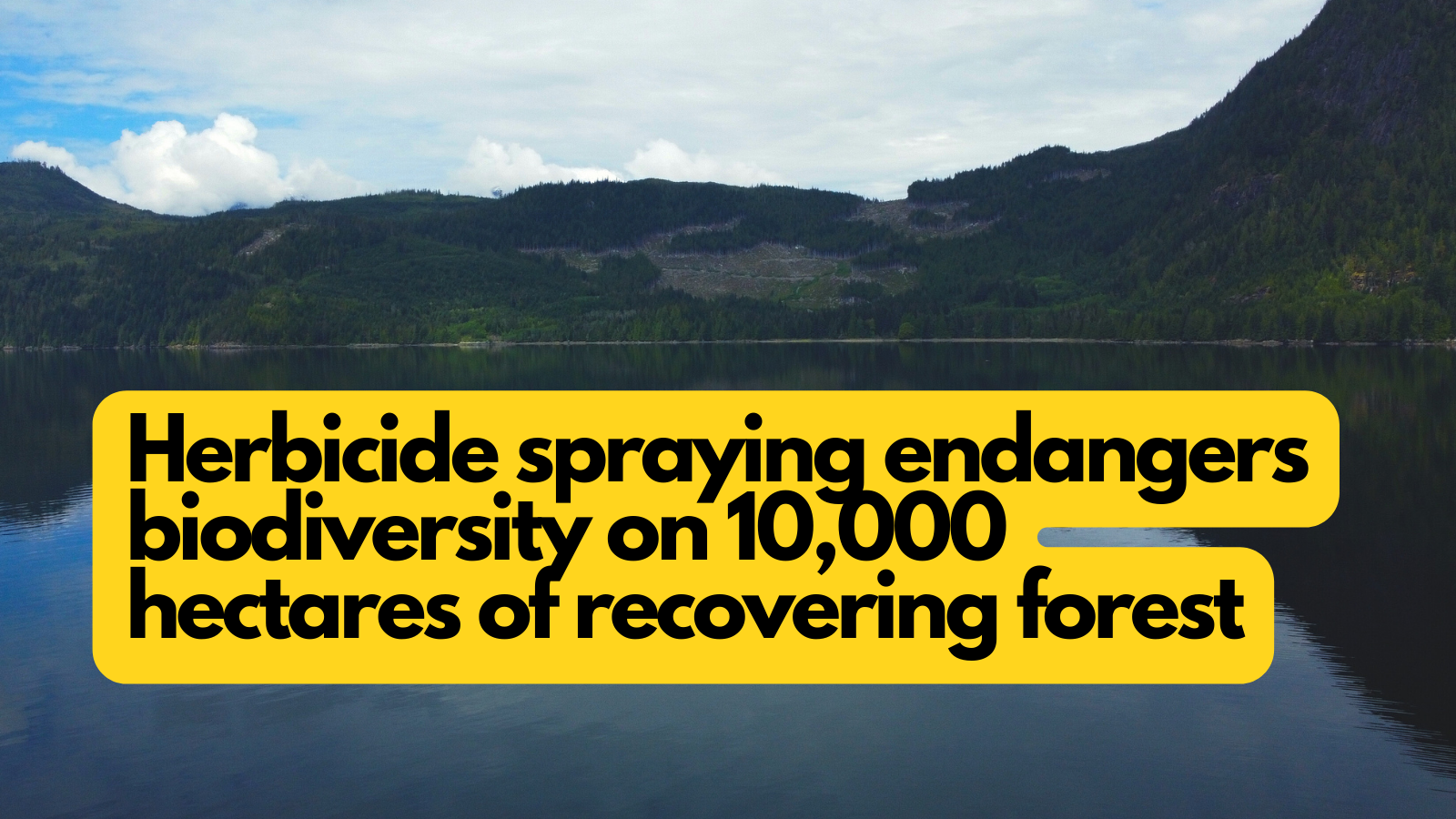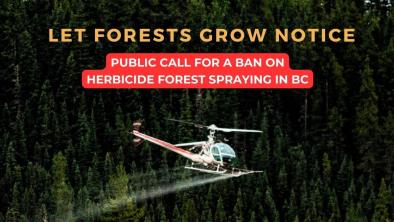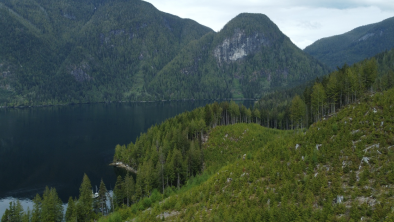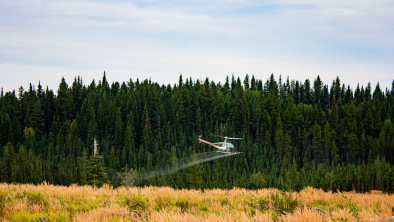Toxic glyphosate to be sprayed over Ma’amtagila Nation territory
Wilderness Committee

In areas around Johnstone Strait hit hard by past logging, herbicide spraying on nearly 10,000 hectares of recovering forest further threatens biodiversity
B.C. forest management plans show scheduled spraying of glyphosate, a herbicide that kills plants, fungi and bacteria, on forests throughout the territory of the Ma’amtagila and neighbouring Nations. In total, 9,840 hectares of land — equivalent to the area of 24 Stanley Parks — are scheduled to be sprayed this summer. The spraying will happen mostly on Ma’amtagila territory including areas adjacent to Johnstone Strait, spanning from Sonora Island, east to Cracroft Island and north to Heydon Bay and Glendale Cove.
Glyphosate is a probable carcinogen and has been shown to impact species at risk, bees and amphibians. In the logging industry, it’s used by companies to help grow cash-crop commercial species and kill non-profitable ones. Often these non-commercially profitable species are native plants important for wildlife, traditional food, medicine and ecosystem health.
"When I think about the spraying it pains me to know that all of that traditional medicine is being destroyed. This practice is banned in Quebec, yet we’re still spraying it here in B.C. There must be transparency about the true impacts of glyphosate because we're the ones that suffer when we’re not consulted in good faith as First Nations people,” said Gigame Mak'wala, Chief Rande Cook of Ma'amtagila First Nation. “It's time to stop stealing from ecosystems and start healing them."
A “notice of intent to treat plan” was shared by a logging company with a member of an impacted First Nation community after they asked the government for the plans. This plan showed 500 cutblocks, covering almost 10,000 hectares, were set to be sprayed. Notice of intent to treat plans show the exact locations where spraying will occur are made yearly. But these maps are only available to the public or First Nation communities if companies or the government decide to share them, but they are not required to.
Pest management plans are publically available and are only issued every five years. These plans do not show the areas to be sprayed, they show the larger boundary of the area. Because of this spraying often happens in areas without public knowledge. The only requirement a company must do to notify of the specific spraying is to put up a sign near the area after it was sprayed.
“This is a public health risk. Glyphosate is a probable carcinogen and biodiversity killer. Communities deserve to know at the very least exactly where spraying is occurring and when,” said Charlotte Dawe, conservation and policy campaigner for Wilderness Committee. “There is no avenue within the Integrated Pest Management Act that automatically allows a First Nation community or public member access to spray plans, they’re only revealed if the government or industry voluntarily decide to hand them over. That’s a disgrace.”
Consultation on glyphosate spray plans occurs once every five years when the pest management plan is created. If the public misses that consultation window, the next five years of spraying can happen under secrecy and without consideration and input on issues regarding community health, wildlife and wilderness concerns. However, even if the public does give input, logging companies have no legal obligation to consider any opposition nor do they need to agree to provide any annual notifications.
“Government has said that the traditional users cannot build roads, cannot build trails but industry is in there doing all those things, even through our trap line,” said Gigame Pudlidagame, Chief Brian Wadhams of Ma’amtagila First Nation. “Industry can build roads, rip down trees, and poison the land and the government turns a blind eye but when it comes to standards for First Nation users they’re strictly enforced.”
Earlier this year, the Wilderness Committee, Awi'nakola Foundation and members of Ma’amtagila Nation conducted site visits to some of the areas about to be sprayed to document the plants and wildlife. The groups documented diverse wildlife within the spray boundaries. Many documented plant species within the spray boundaries are of significance for traditional food and medicinal purposes, such as elderberry, salmonberry, huckleberry, cherry and thimbleberry. Also within the landscape set to be sprayed were species essential to ecosystem recovery, including alder and fungi. When glyphosate is used, these species are harmed or killed, depending on concentration.
“The area they are spraying are traditional gathering lands, going back past my grandfather, past traplines and pre-European contact,” said Wadhams. “I grew up on these lands and they hold irreplaceable value when it comes to traditional medicines, foods, clam digging, prawn fishing and hunting, essential to family and community health.”
The groups are calling for a ban on glyphosate in forestry uses, and for the government to update their outdated pest management plan process so all mapping is publicly available and consultation and consent seeking occurs yearly. The government should align their pest management plan with the United Nations Declaration on the Rights of Indigenous Peoples (UNDRIP) to require free prior and informed consent so other ecosystem values are considered over logging profits.
Chiefs Cook and Wadhams are requesting an emergency meeting for the territories around Call Inlet and are demanding the province and companies seek permission prior to any further spraying or logging activities to uphold UNDRIP, trapline rights and respect the inherent rights of Kwakwaka'wakw people to safely access harvesting grounds. They are requesting a consistent and transparent approach throughout all of Kwakwaka'wakw territory.
–30–
Photos of the territory to be sprayed
Background information
- International Agency on Research for Cancer Monograph on Glyphosate
- EPA Finds Glyphosate Is Likely to Injure or Kill 93% of Endangered Species
- Effects of the Herbicide Glyphosate on Honey Bee Sensory and Cognitive Abilities: Individual Impairments with Implications for the Hive
- Glyphosate toxicity for animals
For more information, please contact:
Chief Rande Cook | Ma’amtagila Nation
250-704-6777
Chief Brian Wadhams | Ma’amtagila Nation
250-974-4904
Charlotte Dawe | Conservation and Policy Campaigner
778 903 3992, charlotte@wildernesscommittee.org
Mark Worthing | Awi'nakola Foundation
250-889-3575
Fancy meeting you here at the end of this article! Care to hang out together for a few more sentences?
The campaign you just read about is one of about 20 we’re actively working on at any given time. And the person who wrote this article is the same campaigner who’s asking you to take action, who’s calling on our legislators to make changes and who’s in the field to bring you photos, videos and stories documenting this issue.
Did you notice how we’re a bit distinct, that we’re not afraid to call out the industries or governments that threaten what’s wild? Unlike other groups, we’re almost 100 per cent* “people powered.” Individuals like you who care give what they can, when they can. No corporate or government funding restricts our strategies, our actions or our voice. That’s how we stay a lean, nimble and unequivocally relentless voice for wilderness, wildlife and the climate. That’s why we’d love it if you’d consider joining us by making a monthly donation to the Wilderness Committee today.
LET'S MAKE A DIFFERENCE TOGETHER
We’ve already established you like to read to the end, so here’s the fine print. It’s 96 per cent of our funding which comes from individuals like you and me. About four per cent of our total funding comes from a few grants from foundations. Every gift — no matter the size — has an impact and powers our work for nature.


